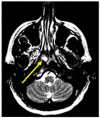The risks and benefits of searching for incidental findings in MRI research scans
- PMID: 18547199
- PMCID: PMC4290840
- DOI: 10.1111/j.1748-720X.2008.00274.x
The risks and benefits of searching for incidental findings in MRI research scans
Abstract
We weigh the presumed benefits of routinely searching all research scans for incidental findings (IFs) against its substantial risks, including false-positive and false-negative findings, and the possibility of triggering unnecessary, costly evaluations and perhaps harmful treatments. We argue that routinely searching for IFs may not maximize benefits and minimize risks to participants.
Figures



References
-
- Meadows J, et al. Asymptomatic Chiari Type I Malformations Identified on Magnetic Resonance Imaging. Journal of Neurosurgery. 2000;92(6):920–926. - PubMed
-
- Illes J, et al. Ethical Consideration of Incidental Findings on Adult Brain MRI in Research. Neurology. 2004;62(6):888–890. - PMC - PubMed
- Katzman GL, et al. Incidental Findings on Brain Magnetic Resonance Imaging from 1000 Asymptomatic Volunteers. JAMA. 1999;282(1):36–39. - PubMed
- Kim BS, et al. Incidental Findings on Pediatric MR Images of the Brain. American Journal of Neuroradiology. 2002;23(10):1674–1677. - PMC - PubMed
- Kumra S, et al. Ethical and Practical Considerations in the Management of Incidental Findings in Pediatric MRI Studies. Journal of the American Academy of Child and Adolescent Psychiatry. 2006;45(8):1000–1006. - PubMed
- Weber F, Knopf H. Incidental Findings in Magnetic Resonance Imaging of the Brains of Healthy Young Men. Journal of the Neurological Sciences. 2006;240(1-2):81–84. - PubMed
Publication types
MeSH terms
Grants and funding
- K02 MH 74677/MH/NIMH NIH HHS/United States
- R01 DA017820/DA/NIDA NIH HHS/United States
- R01 HG 003178/HG/NHGRI NIH HHS/United States
- R01 HG003178/HG/NHGRI NIH HHS/United States
- R01 MH036197/MH/NIMH NIH HHS/United States
- MH 068318/MH/NIMH NIH HHS/United States
- R01 MH068318/MH/NIMH NIH HHS/United States
- MH 59139/MH/NIMH NIH HHS/United States
- MH 16434/MH/NIMH NIH HHS/United States
- DA 017820/DA/NIDA NIH HHS/United States
- R01 MH059139/MH/NIMH NIH HHS/United States
- K02 MH074677/MH/NIMH NIH HHS/United States
- MH 36197/MH/NIMH NIH HHS/United States
- T32 MH016434/MH/NIMH NIH HHS/United States
LinkOut - more resources
Full Text Sources
Medical

